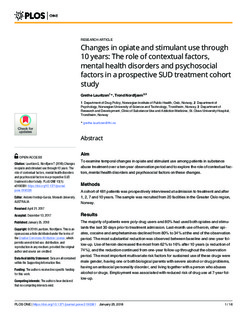| dc.contributor.author | Ostling, Grete Lauritsen | |
| dc.contributor.author | Nordfjærn, Trond | |
| dc.date.accessioned | 2018-08-13T11:17:27Z | |
| dc.date.available | 2018-08-13T11:17:27Z | |
| dc.date.created | 2018-01-10T22:13:38Z | |
| dc.date.issued | 2018 | |
| dc.identifier.issn | 1932-6203 | |
| dc.identifier.uri | http://hdl.handle.net/11250/2557738 | |
| dc.description.abstract | Aim
To examine temporal changes in opiate and stimulant use among patients in substance abuse treatment over a ten-year observation period and to explore the role of contextual factors, mental health disorders and psychosocial factors on these changes.
Methods
A cohort of 481 patients was prospectively interviewed at admission to treatment and after 1, 2, 7 and 10 years. The sample was recruited from 20 facilities in the Greater Oslo region, Norway.
Results
The majority of patients were poly-drug users and 80% had used both opiates and stimulants the last 30 days prior to treatment admission. Last-month use of heroin, other opiates, cocaine and amphetamines declined from 80% to 34% at the end of the observation period. The most substantial reduction was observed between baseline and one-year follow-up. Use of heroin decreased the most from 62% to 16% after 10 years (a reduction of 74%), and the reduction continued from one-year follow-up throughout the observation period. The most important multivariate risk factors for sustained use of these drugs were male gender, having one or both biological parents with severe alcohol or drug problems, having an antisocial personality disorder, and living together with a person who abuses alcohol or drugs. Employment was associated with reduced risk of drug use at 7-year follow-up.
Conclusions
There was a substantial reduction in opiate and stimulant use from baseline to all follow-up assessments, most greatly for heroin. Findings regarding sustained use could suggest familial transmission and the challenges of preventive strategies and treatment efforts in an intergenerational context. Co-occurrence between drug abuse and mental health problems highlights the need of highly specialized competence in SUD treatment. | nb_NO |
| dc.language.iso | eng | nb_NO |
| dc.publisher | Public Library of Science | nb_NO |
| dc.rights | Navngivelse 4.0 Internasjonal | * |
| dc.rights.uri | http://creativecommons.org/licenses/by/4.0/deed.no | * |
| dc.title | Changes in opiate and stimulant use through 10 years: The role of contextual factors, mental health disorders and psychosocial factors in a prospective SUD treatment cohort study | nb_NO |
| dc.type | Journal article | nb_NO |
| dc.type | Peer reviewed | nb_NO |
| dc.description.version | publishedVersion | nb_NO |
| dc.source.volume | 13 | nb_NO |
| dc.source.journal | PLoS ONE | nb_NO |
| dc.source.issue | 1 | nb_NO |
| dc.identifier.doi | 10.1371/journal.pone.0190381 | |
| dc.identifier.cristin | 1540341 | |
| dc.description.localcode | © 2018 Lauritzen, Nordfjærn. This is an open access article distributed under the terms of the Creative Commons Attribution License, which permits unrestricted use, distribution, and reproduction in any medium, provided the original author and source are credited. | nb_NO |
| cristin.unitcode | 194,67,40,0 | |
| cristin.unitname | Institutt for psykologi | |
| cristin.ispublished | true | |
| cristin.fulltext | original | |
| cristin.qualitycode | 1 | |

